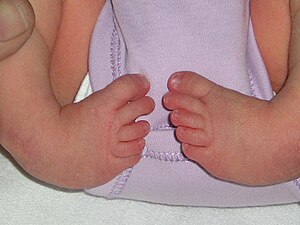Clubfeet
| Clubfoot | |
|---|---|
| Synonyms | Clubfoot, congenital talipes equinovarus (CTEV) |
 |
|
| Bilateral clubfoot | |
| Specialty | Orthopedics |
| Symptoms | Foot that is rotated inwards |
| Usual onset | During early pregnancy |
| Causes | Unknown |
| Risk factors | Genetics, mother who smokes cigarettes |
| Diagnostic method | Examination, ultrasound |
| Similar conditions | Metatarsus adductus |
| Treatment | Ponseti method (manipulation, casting, cutting the Achilles tendon, braces), French method, surgery |
| Prognosis | Good with treatment |
| Frequency | 1 in 1,000 |
| Classification |
· ·
|
|---|---|
| External resources |
Clubfoot is a birth defect where one or both feet are rotated inwards and downwards. The affected foot, calf, and leg may be smaller than the other. In about half of those affected, both feet are involved. Most cases are not associated with other problems. Without treatment, people walk on the sides of their feet which causes issues with walking.
The exact cause is usually unclear. A few cases are associated with distal arthrogryposis or myelomeningocele. If one identical twin is affected there is a 33% chance the other one will be as well. Diagnosis may occur at birth or before birth during an ultrasound exam.
Initial treatment is most often with the Ponseti method. This involves moving the foot into an improved position followed by casting, which is repeated at weekly intervals. Once the inward bending is improved, the Achilles tendon is often cut and braces are worn until the age of four. Initially the brace is worn nearly continuously and then just at night. In about 20% of cases further surgery is required.
Clubfoot occurs in about one in 1,000 newborns. The condition is less common among the Chinese and more common among Maori. Males are affected about twice as often as females. Treatment can be carried out by a range of healthcare providers and can generally be achieved in the developing world with few resources.
In clubfoot one or both feet are rotated inwards and downwards. The affected foot, calf, and leg may be smaller than the other. In about half of those affected, both feet are involved. Most cases are not associated with other problems. Without treatment, people walk on the sides of their feet which causes issues with walking.
...
Wikipedia
